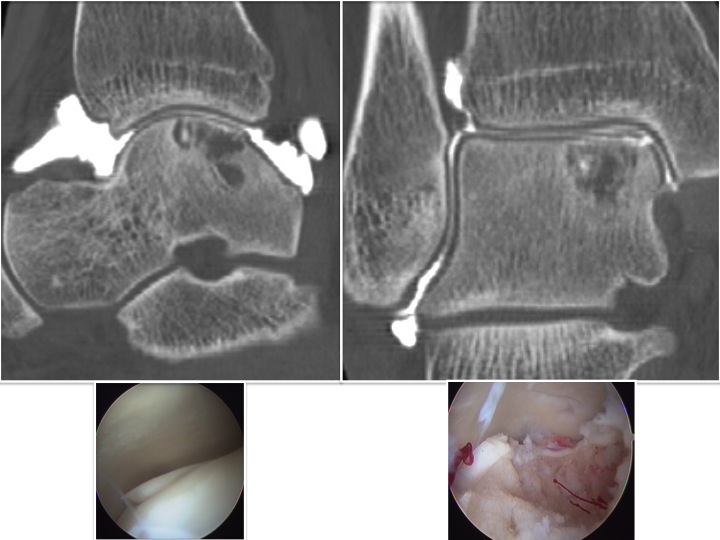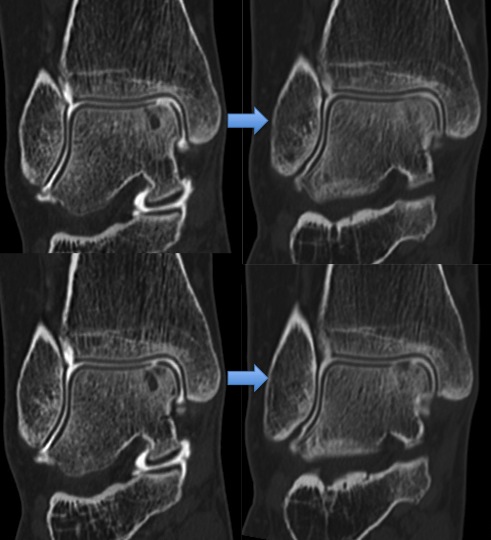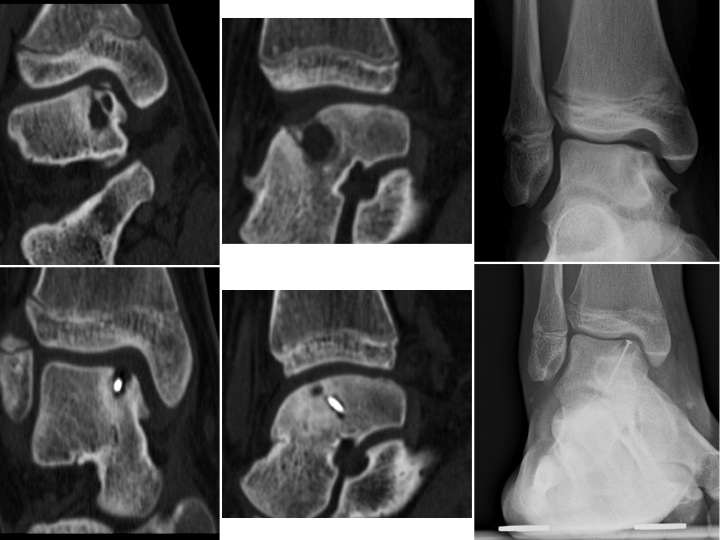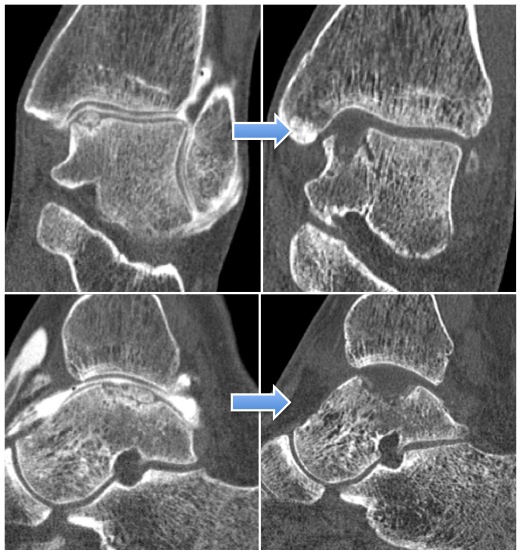Osteochondral defect or Cyst
Definition
When two bones move relative to each other, their surface consists of a softer substance that we call cartilage. In most joints of the foot and ankle, this layer of cartilage is one to a few millimetres thick. To make these surfaces slide more easily, there is also fluid in the joint that is created by the capsule of the joint.
An osteochondral defect can be described as an interruption of the normal lining of a joint surface in which both the cartilage and the directly underlying bone are affected. A cyst can be seen as a cavity filled with synovial fluid.
Causes, symptoms and treatment
Sprains and fractures can lead to injuries of this cartilage. Depending on the direction, rotation and size of the forces that occur at the time of the trauma, such a cartilage injury can range from a simple tear to non-displaced and displaced fractures, with or without a portion of the underlying bone, attached to the cartilage.
A simple tear may go unnoticed and heal spontaneously without you ever knowing it. Because of the pressure in the joint, however, it may also happen that the synovial fluid is pushed into this crack and quietly creates an accumulation of fluid in the bone (osteochondral cyst), just below the cartilage. At that time, patients can have three different kinds of complaints, whether or not in combination:
- Deep pain in the joint, stress-related: Because of the increase of pressure while standing or walking, the pressure in the cyst is increased as well. Since the sensory nerves are present there, the pain increases as well.
- Locking sensation: sometimes, a piece of cartilage is only partially linked after some time. Because of that, it can pivot and move during a certain motion, which gives patients the feeling that something blocks the normal smooth movement of a joint. Something seems to jump.
- Instability: some patients complain after a sprain, e.g. of the ankle, of an unstable feeling, accompanied by pain. This may be due to a tear in the ligaments of the joint but also to the presence of a cartilage injury. When a certain movement provokes pain, one can have the feeling of falling through the ankle, without it being unstable.
Depending on the location, the size of the injury, your age and previous treatments, several kinds of surgery may be proposed:
- Exploratory arthroscopic operation with debridement and microfracture: in this case, there is an arthroscopic debridement of the cartilage injury, which is done through 2 small skin incisions and by means of a camera and other instruments. As a result, the pressure is reduced.This in itself has, according to the literature, a success rate of 60%. However, if in addition, several holes are made in the underlying bone, enhancing a better bleeding, improvement can be hoped for in 85% of the patients. After surgery, a pressure bandage is applied for three days, you are prompted to move the ankle as much as possible, but also “demanded” not to bear weight for 6 weeks on the operated leg. The reason for this latter is our hope that the hematoma will turn partly into bone and partly into a kind of cartilage that will attach to the existing bone and cartilage.While leaning, the synovial fluid is under pressure and can more easily push its way through the hematoma and the remaining bone and cartilage, creating a new type of cartilage injury, with relapse as a result.


- Open surgery (arthrotomy or osteotomy): same procedure as above, just not through a arthroscopic surgery.

- Osteochondral grafting: the osteochondral graft can either be taken from the knee, or consist of synthetic material, either come from the bone bank. Since this also has a success rate of “only” 85%, like arthroscopic debridement and microfracturing, the latter is always performed primarily.
- Massive allograft: in case of large cysts, part of the talus can be replaced with donor bone.
In case of a non-displaced fracture, you are asked not to lean for 6 weeks. Since ligament lesions are often present as well, a cast should be applied for a few weeks, with or without mobilization exercises by a physiotherapist.
If the cartilage injury has torn off part of the underlying bone and has moved into the joint, the treatment will depend on the size of the fragment. If it is too small to be secured in its place with a screw, it can simply be removed, after which a debridement and microfracture should be done where the fragment came from. In the case of fixation, we find ourselves in a similar situation as of a non-displaced fracture.
Another entity is an osteochondritis dissecans, in which an osteochondral injury has occurred during the development of the body. After a trauma, or spontaneously, this fragment can become mobile, causing inflammation around the lesion. Treatment may include:
- A retrograde drilling of the lesion, of which it is hoped that the fragment will grow together;
- Arthroscopy or open surgery with debridement and microfracture.

In the case of complete diffuse or local disappearance of cartilage in a joint, we can speak of osteoarthritis (cf. section “osteoarthritis”).

